We continue our run in Africa, which is just how the alphabetical “randomization” of this project had it turn out. This time, we’re in Chad, the immediate neighbor to the north of our last entry in the Bread & Soup Project, the Central African Republic. 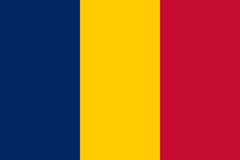 What do we need, or want, to know about this country? It’s big enough to have both a fertile savanna area to the south and a huge desert to the north, and includes the second largest wetlands area in Africa. Overall, at almost a half million square miles, it’s slightly larger than Washington, Oregon, California, and Nevada combined, but has a population of less than half of California’s. The largest city and capital, N’Djamena, is roughly the size of San Francisco, with almost double the population.
What do we need, or want, to know about this country? It’s big enough to have both a fertile savanna area to the south and a huge desert to the north, and includes the second largest wetlands area in Africa. Overall, at almost a half million square miles, it’s slightly larger than Washington, Oregon, California, and Nevada combined, but has a population of less than half of California’s. The largest city and capital, N’Djamena, is roughly the size of San Francisco, with almost double the population.
The population encompasses around 200 distinct ethnic groups, and has as many different languages spoken. The official languages of the country are Arabic and French and religiously, about 52% are Muslim and 44% Christian. It’s currently run by a provisional government overseen by a military junta, which has been true since the 1970s, after gaining independence from France in 1960.
The staple crop of Chad is millet, which is pretty much eaten daily by everyone in one form or another – the most common being a sort of dumpling that’s used to bulk up soups or stews or dipped into sauces. Lake fish is the most popular, or at least most common, protein source, often dried or smoked. The fertile savanna in the south produces a wide range of vegetables, and a huge percentage of the diet is vegetarian simply by necessity, Chad being the 7th poorest country in the world.
Another country that finding a selection of recipes wasn’t easy. Initially, I’d wanted to make the national soup, daraba, but its main ingredient is okra, which is out of season here, and won’t be in season for another 7-8 months. Various other possibilities presented themselves, and in the end, I simply picked one that I knew I could easily get all the ingredients for, a cowpea (black-eyed pea) soup. I wasn’t even able to find a traditional name for it. On the bread side, I could have made the millet dumplings, but I wanted something that was more bread-like, and I found kisra, a flatbread, almost more a crepe, that Chad shares with neighboring Sudan. The difference between the two is that in Sudan it’s made with ground sorghum and in Chad, with ground millet.
The ingredients for our soup this time? A pot of cooked cowpeas – they’re quick, they don’t need to be soaked, about half an hour in lightly salted water. Set those aside. The rest, a chopped onion, some chopped garlic, ginger, and chili, a diced sweet potato, a couple of chopped tomatoes, and a mix of spices – salt, pepper, cumin, coriander, turmeric, clove, and cardamom.
Cook the onion in a little oil until soft and translucent, about 10 minutes. Then add the garlic, ginger, and chili and cook for a couple of minutes more. Then add the spices and cook for one minute to develop their aromatic oils.
Add the sweet potato, tomato, and half of the cowpeas. Cover with just enough water to reach the top of the vegetables. Bring to a boil and then simmer until the sweet potatoes are completely soft, about 15-20 minutes.
Coarsely mash the mixture, or use a stick blender to create a coarse puree. You could do this in a regular blender, but just pulse it a few times. Then add in the other half of the cowpeas, and top off with enough water to create a thick soup (it was roughly equal water to the volume of the second half of the cowpeas). Simmer together for about five minutes, adjust the seasoning – it definitely needed more salt at this point. And, it’s done.
Perhaps I should have begun with the kisra, because this actually needs to start about 12 hours earlier, like the night before, or first thing in the morning. First off, I couldn’t find any ground millet or millet flour, so this is whole grain millet. It’s more than I needed, as I quickly found out, and I only used about half of this (I really only needed a couple of flatbreads, not 8-10 as the recipe volume made.
I simply ground the millet in my spice grinder in a couple of batches to get a coarse flour, kind of the texture of polenta or semola.
Added about half the volume in water, just enough to make a thick paste, and then left it sitting in a warm area for at least 12 hours to lightly ferment. I gave it a stir every few hours, just to mix up the exposed surface so it didn’t dry out, and fermented more evenly. It gets just slightly sour.
Then, mixed the fermented paste with a little bit of wheat flour and some more water – it’s got the consistency of a crepe batter – a bit thinner than pancake batter. The little block to the left is beef suet, which is what these are traditionally cooked in. I didn’t remotely use that whole block, I just used it to grease the pan as I went along.
And, over low heat, basically cook like somewhat thick crepes. Grease the skillet or crepe pan with the beef fat, ladle in some of the batter, spread it out, and cook until…
…golden brown underneath. Then flip it, brown the other side, and… done.
And, here we have our kisra, our millet flabread, and cowpea, or black-eyed pea, soup. I really liked both. The soup has a good kick to it with the ginger and chili, plus the spices, and would be a great “bean soup” for cold weather, which we’re headed towards here. The millet flatbread has a really interesting toasty flavor to it. I don’t eat much millet, but I like it. Probably the dumplings would be more traditional, to add into the soup, or dip into it, but the flatbread worked just fine, tearing off a piece at a time and scooping up the soup, which was thick enough to do that with. Overall, a good, and interesting, round for this project.
Next time, a bit closer to home, as we head to Chile!
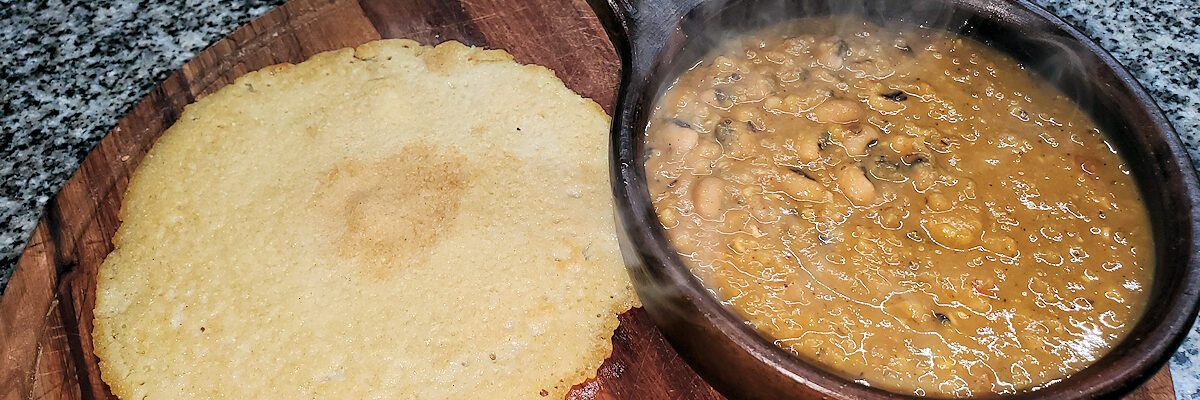
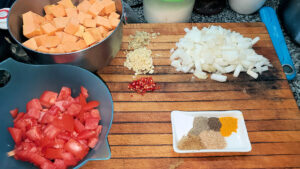
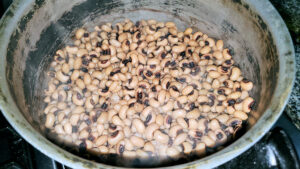
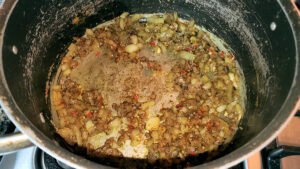
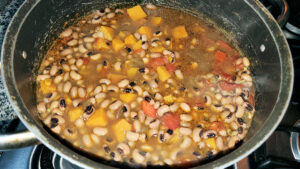
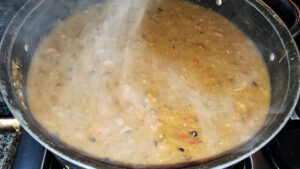
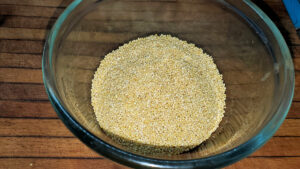
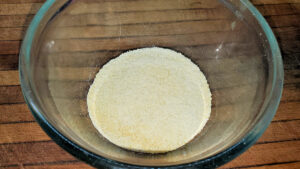
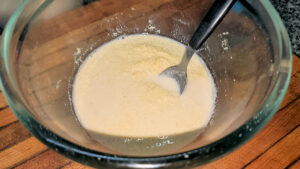
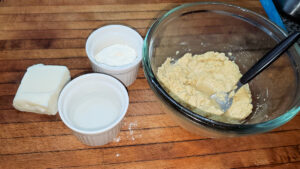
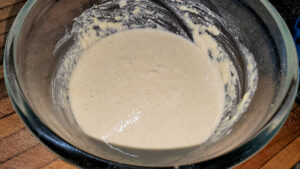
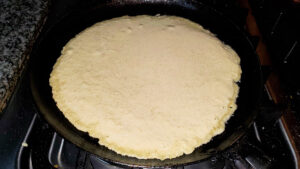
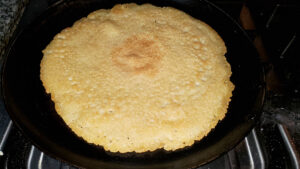
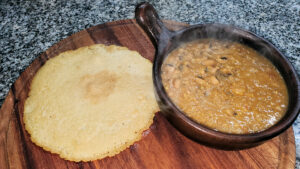
[…] Next up, staying in Africa, we head to neighboring Chad. […]
[…] and partially because it’s a recipe almost identical to the flatbread kisra that I made for the recent entry on Chad, just slightly thicker, and more commonly made with either sorghum or teff […]